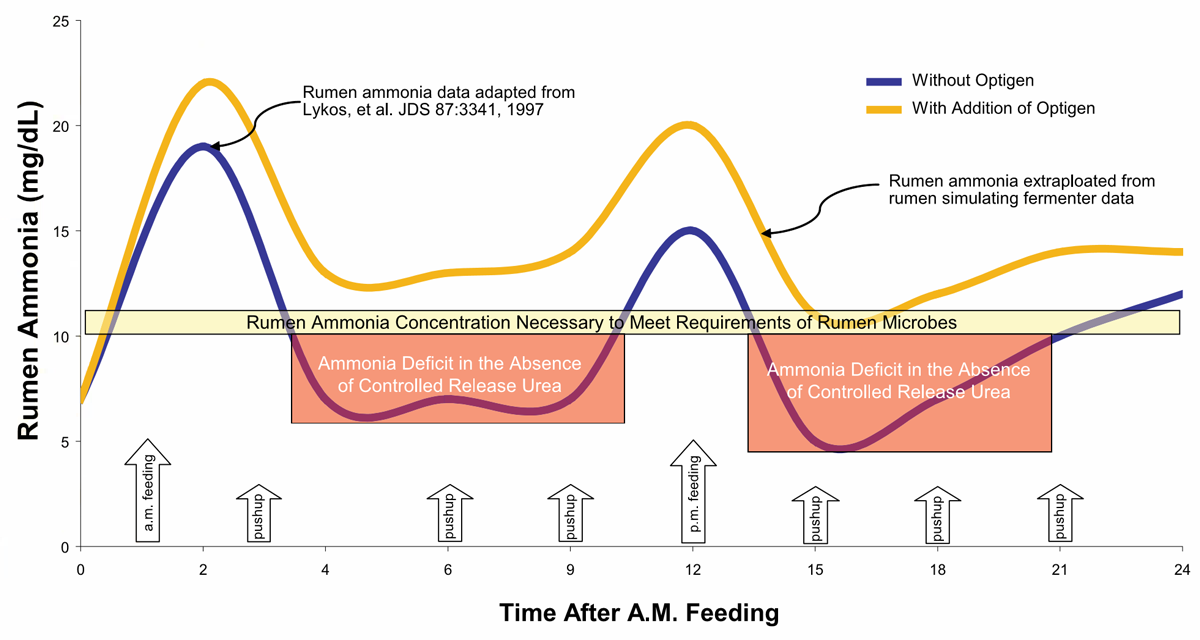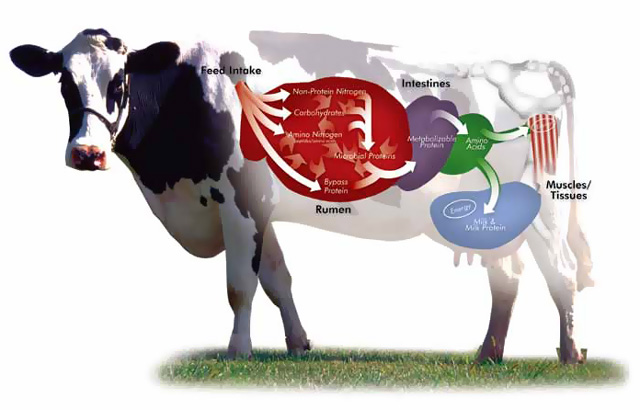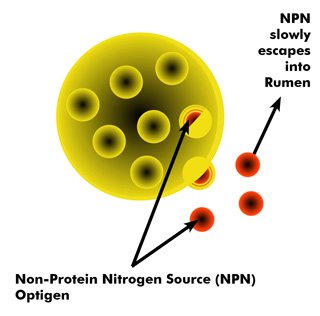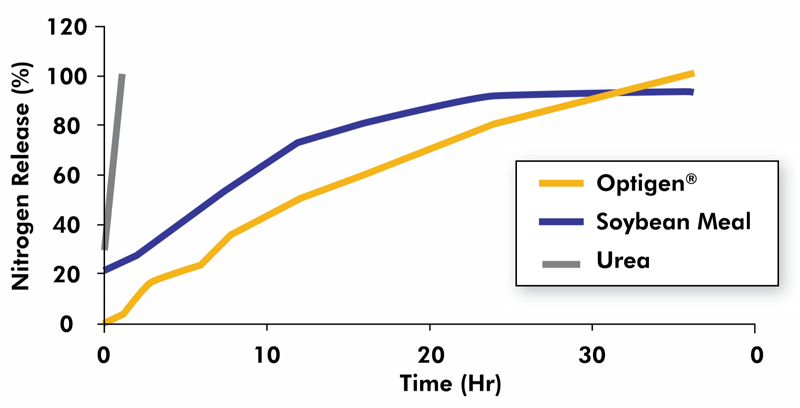The advantage of including Optigen in ruminant rations is an increased yield of microbial protein from the rumen. This protein has an optimal amino acid profile and will provide more essential amino acids than soya and other vegetable based protein sources. In Dairy diets up to 0.75Kg of Soya could be replaced by 100g of Optigen. This will improve carbon efficiency and reduce costs. Similar benefits have been demonstrated for beef systems.
Depending on the targets of the individual producer, all or any of the benefits can be achieved:
Replacing the removed soya with energy from home grown wheat and good quality corn silage combined with 100 grams of Optigen gave more milk, plus 1.6 L, more fat, 3.6 -4.0, and more protein 3.4- 3.5 all from the same intake.
Incorporating Optigen at 100% removal of 900g of soya/canola combination replaced cost effectively with corn silage/alfalfa. Milk remained stable, fat % increase 0.4%.
Reduction of total diet crude protein by removing up to 800 grams of soya, canola & sunflower mixture, can be replaced with more effective Opitgen plus grass/corn silage. Resulting in a less costly ration, with the same milk production.
These formulation changes away from traditional vegetable protein to Optigen with cereal or forage combinations also show clear benefits in:
Optigen is a technology that accommodates ration formulation to meet the needs of the rumen microbial population more effectively, resulting in increased microbial population growth, increased fibre digestion and improved efficiency of rumen nitrogen capture.

The rumen bacteria, particularly those responsible for fibre degradation, have a specific requirement for ammonia of 10-15 mg dl at a constant level throughout the day.
This is required to ensure the bacteria can have access to enough nutrients to flourish. This stimulates the production of milk and increased microbial activity which will improve fibre digestion and microbial protein production.
Under standard dietary formulating situations the reality is that for major parts of the day there is in an imbalance of ammonia. The rumen is in deficit for a considerable period and can be at an unacceptable risky excess at other times.
Coupled with appropriate formulation changes, incorporating Optigen into the diet brings the release of ammonia into balance and its unique controlled release mechanism ensures the optimum supply at all times.
Optigen, by controlling the release, now provides the environment for greater synchronizing of nitrogen and energy to provide greater levels of microbial protein, 10–20% more, the ideal protein source for milk production. Optigen is allowing the reduction of total nitrogen in the diet by ensuring its form is utilized more efficiently with less waste. Optigen ensures more feed nitrogen is converted to bacterial nitrogen.

Rumen friendly diets are the goal of all feed formulators. Diets which are designed to ensure that the animals rumen works most efficiently are also the most cost effective way of ensuring greatest profit without compromising the cows health in the process.
The concentrated nature of Optigen's nitrogen source allows for the replacement of bulky vegetable protein ingredients thereby creating space for the inclusion of additional home grown forage or energy sources which are less costly and more rumen friendly.
Optigen offers itself as the alternative nitrogen source to replace a significant volume of traditional vegetable protein sources and displays similar slow controlled ammonia release.
Alternative methods of supply such as feed urea are not capable of such controlled release and provide for an inadequate, wasteful and possibly risky option.
Between 50% and 90% of ammonia contained in feed grade urea can be wasted before the animal consumes the TMR. Feed grade urea is readily hydrolised on contact with moisture, this occurs both in the feed trough and the rumen. Excess ammonia in the rumen will rapidly enter the blood stream via the rumen wall, increasing blood urea, and having detrimental effects on fertility and liver and kidney function.


The function of slow controlled ammonia release coupled with the provision of dietary space, because of its concentration, accommodates the introduction of component ingredients which provide important advantages such as:
5% MORE Concentrated Nitrogen
Use lower cost ingredients →
Reduce cost of production, less environmental nitrogen waste
Use more digestible carbohydrate →
More Milk
Use more forage →
Healthier rumen, better milk
Optigen: A controlled release technology designed to provide a safe concentrated source of ruminally degradable protein

Controlled release of nitrogen

Slowly converted to ammonia: ammonia produced at an optimum rate for uptake by ruminal bacteria

Allows for an increase in number of fibre-digesting bacteria

More feedstuffs consumed and increased microbial protein produced

Reduced need for supplemental protein

Flexibility in the diet
Optigen® can be formulated into all dairy and beef production TMRs. The only exceptions are diets which are based on high protein forages, for example spring grass.
Optigen has a protein equivalent of 256%! This means that only small amounts are required to replace high-protein ingredients, such as soya or rape.
| %EAA | Milk Protein | Rumen Bacteria | Soya | Rape |
|---|---|---|---|---|
| Arg | 7.2 | 10.2 | 16.2 | 16.5 |
| His | 5.5 | 4.0 | 6.1 | 6.6 |
| Ile | 11.4 | 11.5 | 10.1 | 9.0 |
| Leu | 19.5 | 16.3 | 17.2 | 15.9 |
| Lys | 16.0 | 15.8 | 13.9 | 13.2 |
| Met | 5.5 | 5.2 | 3.2 | 4.4 |
| Phe | 10.0 | 10.2 | 11.6 | 9.5 |
| Thr | 8.9 | 11.7 | 8.7 | 10.4 |
| Trp | 3.0 | 2.7 | 2.8 | 3.4 |
| Val | 13.0 | 12.5 | 10.2 | 11.1 |
Optigen has been designed to stimulate production of microbial crude protein (MCP). The quality of MCP is very close indeed to the amino acid profile found in milk and muscle tissue.
| Protein source | Met | Lys | Met+Lys |
|---|---|---|---|
| Microbes | 97 | 100 | 197 |
| Fish Meal | 100 | 80 | 180 |
| Blood Meal | 45 | 91 | 136 |
| Soyabean Meal | 56 | 70 | 126 |
| Corn Gluten Meal | 100 | 18 | 118 |
| Brewers Grains | 78 | 34 | 112 |
| Meat Meal | 49 | 58 | 107 |
| Alfalfa Meal, Dehydrated | 60 | 46 | 106 |
| Distiller Grains w/solubles | 81 | 24 | 105 |
| Meat and Bone Meal | 49 | 55 | 104 |
| Feather Meal | 23 | 13 | 36 |
In most cases Optigen can replace much higher volumes of these ingredients. For example: 100g Optigen will replace up to 750g soya meal in most situations. We recommend that you talk to one of our nutritionists who can formulate the diet to include all of the advantages of using Optigen in your TMRs.
Find us on Social Media!
Are you using social media? Reach out to us, read updates related to Ruminant Nutrition and the Dairy & Beef Industry as a whole. Lakeland Scottish Feeds & Services are constantly striving to innovate and develop new technologies and products aimed at helping farmers unleash the full potential of their herd!
Get in touch!
Facebook
Find us on
Twitter